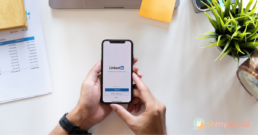9 Steps to creating a B2B content strategy for LinkedIn
As we know LinkedIn is crucial for B2B companies looking to connect with other businesses and professionals. As the world's largest professional site, over 690 million professionals use the platform to network, research and learn*. Hence, it's essential for B2B companies to create engaging content that resonates with their target audience on LinkedIn.
In this blog post, we will provide some tips and strategies for creating effective B2B content for your LinkedIn company page.
1 - Define Your Target Audience
Before creating any content, it's essential you are clear on who your target audience is. Not only will this help you to tailor your content to their specific needs , it will help you later on if you end up sponsoring your posts through LinkedIn Campaign Manager. Take the time to research your target audience's job titles, industry, interests, and pain points.
2 - Share Valuable Insights and Information
To create engaging content on LinkedIn, you need to share valuable insights and information that will benefit your audience. This could include industry trends, current news, best practices, or thought leadership content. By sharing valuable information, you position your company as a thought leader in your industry, which can help build trust and credibility with your target audience.
3 - Use Eye-Catching Visuals
Visuals are essential on LinkedIn, as they help your content stand out in a crowded feed. According to LinkedIn, posts with images receive 2x more engagement than those without. So, make sure to use eye-catching visuals such as images, carousels, videos, or infographics to accompany your content. When using visuals, ensure they are high-quality, on-brand, and relevant to your content.
4 - Keep it Short and Sweet
The ideal length for a LinkedIn post is between 50 and 150 words, with a clear and concise message. If you need to share a more in-depth piece of content, consider LinkedIn articles.
5 - Use Hashtags
Hashtags are an effective way to increase the visibility of your content on LinkedIn. When using hashtags, make sure to use relevant and specific ones that align with the message and target audience.
6 - Engage with Your Audience
Engagement is key on LinkedIn, so make sure to engage with your audience by responding to comments, asking questions, and starting discussions (polls are useful for this). Engaging with your audience helps you to build relationships, gain insights into their needs and increase the visibility of your content.
7 - Mix Up Your Content Formats
Content formats include text-based posts, videos, images, carousels, infographics and polls. By using a variety of content formats, you can appeal to different learning styles and keep your content fresh and interesting.
8 - Analyse Your Performance
It's essential to analyse your performance regularly. LinkedIn provides insights and analytics on your content's reach, engagement and demographics, which can help you identify what's working and what's not. Use this data to optimise your content strategy and improve your engagement rates.
9 - Consider Sponsored Content
While organic content is essential, it's becoming increasingly difficult to reach your target audience without paid promotion. Consider investing in sponsored content, which allows you to promote your content to a specific audience based on their demographics, interests, and behavior. Sponsored content can help you reach a larger audience and generate leads for your business.
Creating engaging B2B content for your LinkedIn company page requires a strategic approach. By following the tips above you can create a content strategy that resonates with your target audience and generates leads for your business. At Oh my social we understand the importance of creating engaging B2B content on LinkedIn and would be happy to help you create a content strategy that meets your business objectives. Get in touch with us today at [email protected].
*Source: LinkedIn.com
7 Tips for Preparing Your Seasonal Social Marketing Plan

What is seasonal content and how can you start using it as part of your brand or business social marketing strategy?
Every season has unique events, national and international days and holidays, and when your business or brand talks about these events in a strategic way it is called seasonal marketing. For example John Lewis’ annual Christmas advert is a business making use of the holiday season in December. Now, their Christmas advert is one of the most anticipated campaigns every year: a seasonal calendar is a useful and effective element of your social media marketing strategy.
Why is seasonal content useful?
If you’re a marketer you likely already know the important role that seasonal content can play in your marketing strategy. Seasonal content isn't a direct conversion / sales tactic, but rather a method that can help with:
- Reaching new audiences
- Showcasing your interests / expertise
- Acknowledge topics also relevant to your existing audience
- Personalising your brand with an awareness of current events
- Productivity in delivering timely content
- Filling up your editorial calendar
It’s important to choose topics that have a natural connection to your brand, which you will understand more after completing a thorough social media audit. You can use our seasonal social media calendar to identify relevant national days and incorporate this into your strategy.
See below for some great seasonal social media examples we've showcased on our Instagram page:
https://www.instagram.com/p/BxfA9-dHlyr/?utm_source=ig_web_copy_link
In this instance Air Malta have capitalised on the Eurovision song contest by sharing a great picture of crew members with their competition representative. They have tagged the singer, Michela in the post and wished her luck which resonated well with the followers, many of whom would find this post interesting.
https://www.instagram.com/p/BxuizsnHYem/?utm_source=ig_web_copy_link
Ecommerce homeware brand Bonadea decided to make use of the seasonal event Chelsea Flower Show, by showcasing their floral items and arrangement. A great use of the hashtag and topical event.
https://www.instagram.com/p/BxSkA6UHPYh/?utm_source=ig_web_copy_link
In this case sharing a funny clip from the Met Gala resonated well with the clothing lines audience.
7 Tips for Preparing Your Seasonal Social Marketing Plan:
-
Draft up a yearly marketing schedule
It’s important to sit down as early on in the year as you can to draw up a seasonal calendar. This will help you to keep track of approaching events as the year progresses and will allow you to begin tailoring your marketing materials for each campaign well in advance.
Remember to include a range of different events – from the big ones e.g. Christmas to smaller ones such as World Environment Day on the 5th June.
Our seasonal social calendar is the ideal starting point, summarising all of the key dates coming up in the next 12 months.
https://www.instagram.com/p/Bx15B4uHm8Z/?utm_source=ig_web_copy_link
2. Use seasonal marketing to promote your newest offers:
If you are experiencing higher volumes of traffic from seasonal content, it doesn't hurt to incorporate a promotion to encourage sales. Have a look through the key events in your calendar and consider the most prominent days - can you combine this with a related deal / offer for your customers?
3. Don’t forget about the smaller events:
Smaller events (e.g. Take Your Dog to Work Day) allow you to reach a new audience that may not have otherwise found you via clever use of the hashtag.
By no means do you have to develop a strategy for every single event (there are way too many) but don’t hesitate to engage with the slightly less obvious national days. Is there a blog post already written that you can recycle to get involved with the content of that day? This allows you to continue your marketing strategy without too much effort on your part.
4. Use Data
Have you looked at your analytics to see who your buyers are?
Its worth investing a bit of time into your audience analytics. Not only will this help you create buyer personas when it's time to advertise to a target audience, you can also determine which events and holidays your audience will be interested in. Discover which days your audience prefer and get inspiration from this to factor into your calendar planning.
5. Organise
Once you’ve researched and identified which events and holidays you want to focus on, it’s time to create a plan. You can use an editorial calendar to plan your upcoming social media activity for the year.
6. Decide how you will create content
Once your plan is in place it's worth thinking about how your seasonal content is going to actually look. This could include customised updates, relevant images / video and blog updates.
Think about how this will also impact your written copy, and how you may update things like profile picture, cover image and bio to complement the season accordingly.
7. Schedule in advance
Scheduling in advance takes a great deal of headaches out of remembering what to post and when. Now that your plan is in place and you've created the content, you can use a tool like Tweriod to determine the time that your posts will receive the most engagement. Our preferred scheduling tool is Hootsuite.
Have you started planning your content for the year yet? Perhaps you can start with a social media audit.
Remember, all new subscribers to our mailing list receive a free copy of our calendar download - sign up below:
[yikes-mailchimp form="1" description="1"]
Turning a Blog Post into Social Media content
You can help drive traffic back to a company or brand's website by turning a blog post into social media content. Promoting blog posts on social media gives them longevity and integrates overall marketing efforts - read on to learn how to do it well..
When looking for relevant shareable content for a company or brand, turning a blog post into social media content is the best starting point for spreading the word. They provide up to date valuable info for your audience, gives the company credibility as a thought leader in their industry and directs people to the website (helping to lead to that ultimate sale).
Whether you are looking for work as a Social Media Manager, or already have your clients up and running, you can use social media channels to promote a business' best work and connect with existing and potential customers in new ways. As a Social Media Manager you will almost certainly be repurposing blog post content for social media. This post will help you understand the different ways you can get the message across effectively.
Change content to suit each platform
When chopping up blog post content for social media, consider the platform you're posting on. This can affect whether you chose to post a video, images, slideshare, text only etc, as well as the way you phrase captions and include links, hashtags and locations. The key is to create a social media blueprint for the brand in question - does their audience like video on Facebook? Maybe they respond best to a slideshare on LinkedIn or a series of tweets.
Consider the amount of time that someone will spend scrolling past your post and adapt the content to capture their attention in that time. Remember your ultimate goal is to get views on the blog and links through to the website.
Where to begin
After reading through the post in question, picking out a few key points and interesting quotes there are several steps to take:
1. Decide what platforms are appropriate to share the content:
Instagram post / Instagram stories / Instagram live / LinkedIn / Twitter / Facebook / Facebook live / Similar interest Facebook groups
2. Decide what the post content should look like:
Quotes on images / short summary video / Livestream / Infographic / Slideshare presentation
3. Create the content
4. Decide what time and days to post
5. Add to your social media calendar
Post content types:
- Quick quotes on images
Adding a visual element to your tweets can increase their visibility. You can grasp this by extracting quotable quotes from the blog post, and placing them over an image using a site like Canva to create visual graphics. Your image will need to complement your chosen quote or the title of your blog post. You can use a picture you’ve taken or a stock image from a royalty-free website such as Unsplash, Pexels or Pixabay.
Good for Twitter & Instagram.
Examples:
https://twitter.com/TrippingTreacle/status/1014135675812241409
https://www.instagram.com/p/Bkr5XGjl-S9/
2. Short summary video
Video continues to be a popular way to consume social media and is a good way to get shares and engagement. You can convert the contents of a blog post into a short, social-friendly video. If you remain unconvinced about the power of video check out these stats from Wordstream:
- 45% of people watch more than an hour of Facebook or YouTube videos every week
- One-third of online activity is spent watching video
- 92% of mobile video viewers share videos with others
Example:
https://www.instagram.com/p/BlBwM3OANuf/
3. Facebook / Instagram Live
Going live is a good way to announce the latest posts, generating greater organic traffic than text announcements. The more engaged your community, the more questions and comments you are likely to get on blog posts. A good way to get more interaction with a blog post is to run a live Q&A session on Instagram or Facebook. Users are loving real-time broadcasts and they're a great way to promote a post and give extra value on social.
Instagram Stories are great for posting the news that the latest blog post is live. You can encourage people to interact with the brand through an online poll or pose a question on the blog subject.
4. Infographics
As visual aids, infographics work well on social, are easy on the eye, and easy to digest. They're valuable nuggets of education that users find shareable and blog posts already provide the bulk of the content needed to convert into a visual graphic. You can find many infographic templates on Canva.
https://youtu.be/1jUapcGnT8g
5. Presentation slides
A presentation-style Slideshare or Instagram multi-image post is fantastic for step-by-step tutorial-style content. These translate the post value to users on social and are likely to get a lot of shares and likes. You can use text directly from the content already written, encouraging users to check out the website for the full article.
For this style of content, we recommend LinkedIn or Instagram multi-image posts. LinkedIn tends to be more friendly to long-form content, and you also have the option of sharing longer sections of the post directly to LinkedIn.
https://www.instagram.com/p/BjFVAyFlXdP/
Pinterest is slightly different from other social media platforms. As a visual search engine, pins tend to stay searchable over time. Some brands have argued that pins have more potential to go viral, and Pinterest tends to have profitable target markets as their users generally have a higher income. Gaining traction on Pinterest is a whole tutorial in itself, however, if the brand in question is already active on Pinterest, you can repurpose the post into a shareable pin.
YouTube
When it comes to promoting a blog post, YouTube works a little bit differently from other strategies mentioned above. Content for YouTube is very specific, the audience is more likely to be discovering you for the first time. Because of this, you will need to create relevant content that may not exactly be aligned with your blog post.
For example, to turn this blog post into a YouTube video we could:
- Create a tutorial-style video recording the screen, explaining the post as you scroll down.
- Create a video discussing how to create content for social media, with one of the points being repurposing content from blog posts. We could highlight that last, and then promote this blog post and say “click on the link below for more info about how to turn blog posts into social media content”
When all is posted - don't forget to use analytics
You can track engagement with blog posts back to social media through analytics tools such as Google’s URL Builder. This can tell you a variety of data around the success of posts, including the number of clicks your link receives from the various social media platforms. This data can guide your future social marketing strategies.
Blog posts are prime social content for every social media manager, providing a base for creative energy. If you wish to outsource a social media campaign check out our services. How do you turn your blog posts into social media content? What has been most effective for you? Share your thoughts in the comments below!
How to boost your social media engagement
As brand consultants, one of the questions we are asked frequently is “How do I boost my social media engagement?"
Engagement on social media is the bane of most small business owners lives. How do you build a loyal and active following? How do you increase your followers? How do you increase your reach in general? Well, ohmysocial have put together a few tips and tricks that could help:
-
Post frequently
Whenever you google 'how to increase the amount of followers on a business account', posting frequently will be the tip that comes up most often.
Social media is incredibly fast paced so by posting high quality content consistently, you don't only keep your existing followers but attract new ones too!
-
Use hashtags
Hashtags are another fantastic way to increase engagement on your social media platforms. They allows you to associate your content with certain topics, making you more discoverable. This in turn helps you to connect with your potential target audience.
Did you know? - On Instagram you can have up to 30 hashtags in your posts & using them in your captions, comments, Instagram bios and stories gives your account more visibility.
-
Stay on trend
Staying on trend with topics related to your industry can help you to build a good reputation This is because, by commenting and sharing relevant topics, you appear relatable and newsworthy to your followers.
-
Share other people’s content
Sharing other people’s content, is a great way of diversifying your social media feed as relevant information shared with your followers will keep them engaged. This can be done through:
+ Reposting follower content
+ Using influencers to post (Check out our recent blog post on Influencer Marketing)
+ Guest posting
-
Run contests and giveaways
Many small business owners have found that running contests and giveaways really increases their engagement and following. This is mainly because, people are always more willing to repost and share content if it means they could win a freebie or discount at the end of it.
-
Create polls and surveys
Social media polls and surveys give you access to feedback from your followers quickly and makes your brand more adaptable to creating future marketing strategies.
Gaining a following is tough when you are just starting out as a small business, but with a sound social media strategy and dedication, you can reach your content creating goals. If you need help boosting your social media engagement, get in touch with us today.




